Have you ever gone clothes shopping only to find that half of the garments you select do not flatter your figure? If so, you have experienced the dilemma of one-size-fits-all ready-wear clothing. The best way to bypass that hassle is to learn how to take measurements for clothes!
The best way to take measurements for clothes is to use a flexible tape measure and measure the circumference of key areas of the figure. Measurements needed for clothing include the neck, bust or chest, waist, and hip circumference. Other key areas for fitted clothing include the inseam and the sleeve length.
In this article, you will learn how to take clothing measurements for key areas like the neck and waist. You will find out how a sizing chart works and how it will help you buy the right clothes. Finally, you will learn how to take measurements for clothes like a dress, bra, or jeans.

Quick Navigation
- What are Measurements for Clothes?
- How to Take Measurements for Clothes
- How to Measure for Clothes with a Tape Measure
- How to Take Clothing Measurements for Women’s Clothing
- How to Measure for Men’s Clothes
- How to Use a Sizing Chart
- How Do You Measure Yourself for Clothes at Home?
- How Do Fashion Designers Take Measurements?
- How to Take Body Measurements for Sewing
- How to Measure for:
- Clothing Measurements App
- Conclusion
What are Measurements for Clothes?
Measurements for clothes tell you the circumference or length of key parts of your body. Once you know your measurements, you can match them to a sizing chart provided by a brand or manufacturer. This will help you buy clothes that fit the particular shape of your body.
Learning your measurements is absolutely necessary if you want to order clothes online or if you plan to sew your own clothing. It can also help even if you want to shop in-store because you can look up a brand that you like and see if the measurements will suit you or not.
If you have found that ready-wear clothing often does not fit your body type, you may have body proportions that don’t quite match up with the one-size-fits-all shape of these clothing styles. After all, clothing brands try to make clothes that will fit the highest possible percentage of people, but this aiming for the average approach still leaves out everyone who doesn’t fall within that “average” body type!
Knowing your measurements will help you track down clothes that do conform to your own body type.
If you need clothes for a special occasion, like a wedding or prom, you will need to know your measurements to send them in for a custom-fit gown or tuxedo.
On the other hand, if ready-wear clothes often fit you, you may wonder why you need measurements if you can just look at the size labels inside clothes. You probably know that you usually fit women’s medium, for example. Or perhaps you know that you always wear men’s small shirts.
Here’s the deal: there is no universal rule about sizes in clothing. This means that every brand uses its own measurements for small, medium, and large. This, in turn, means that a small in one brand could fit you, while a small in another brand does not fit you at all!
On top of this, the cut of a garment also plays a considerable role in how it fits you. For example, the waist measurement on a fitted t-shirt will have a much smaller circumference than the waist measurement on a regular tee.
Also, everyone has different body proportions. Your shoulders might fit a medium in that same t-shirt just fine, but if your waist does not, you may need to size up to a large.
You can learn how to take your own measurements in just a few minutes. Write them down or save them on your phone for handy access. Next time you go shopping, you will know the shape and size of your own body, and you can much more easily find clothes that fit you!
How to Take Measurements for Clothes
You can take measurements for clothes by finding the circumference of your neck, chest or bust, waist, and hips and measuring the length of your arm and legs.
Neck

If you wear dress shirts or button-down shirts, you probably know that the collar or neck measurement is one of the most important sizing elements for this type of clothing. The closely fighting buttoned collar on this type of shirt means you need to know the circumference of your neck to find a shirt that fits!
This measurement is typically used for men’s shirts and much less often for women’s shirts.
To take your own neck measurement:
- Locate your Adam’s apple. Find the bottom curve of it and place the end of the tape measure at this point, holding it gently in place with one hand.
- Wrap the tape all the way around your neck. Look in a mirror to make sure the tape remains level as it circles the back of your neck.
- Keep the circle of the tape pulled tightly enough that the tape does not sag, but not so tightly that it feels uncomfortable around your neck.
- Note the measurement where the two ends of the tape meet up at your Adam’s apple.
- Finally, add a half inch to that measurement. You should always add a half inch to the actual circumference of your neck for dress shirt neck sizes.
Sleeve
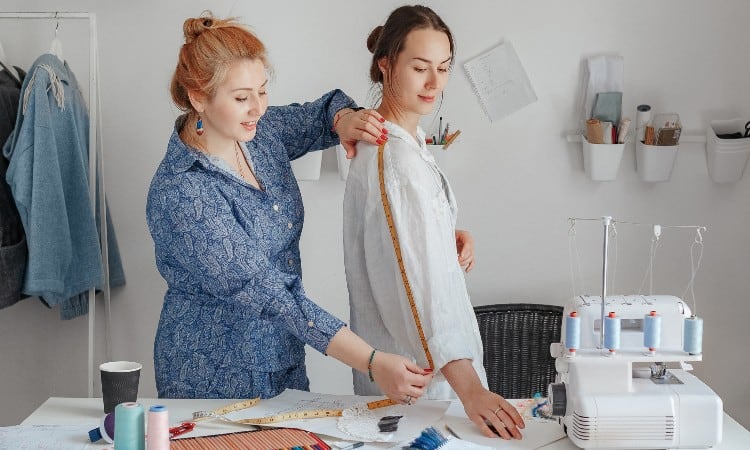
Sleeve length measures the distance from the beginning of your shoulder to your wrist. Knowing this measurement will help you buy any type of garment with long sleeves, from a hoodie to a wedding dress to a dress shirt!
To take a sleeve length measurement:
- Wear a regular t-shirt, as the shoulder seam on this garment will help you with your measurement.
- The best way to get accurate sleeve measurements is to use a particular stance as you measure yourself. Place your feet squarely on the floor at hip distance, hold your shoulders in a loose but firm line, and tuck your hands into the front pockets of your pants.
- Use a mirror to help you locate the center back of your neck. You can feel the knobs of your spine at this point. Plae the tape measure here and hold it with one hand.
- Measure from this center neck point across your shoulder until your reach the shoulder seam in the t-shirt. Write down this measurement.
- Now measure from that shoulder seam point all the way down your bent arm )remember, you have your fingers in your pocket!) to the lowest point of your wrist. You have a knobbly wrist bone that sticks out of the outer edge of your wrist–feel for the bottom curve of that knob and use that as the ending point of your measurement.
- Finally, add up the two measurements you took. The combined shoulder length and arm length will give you an accurate sleeve measurement.
Chest
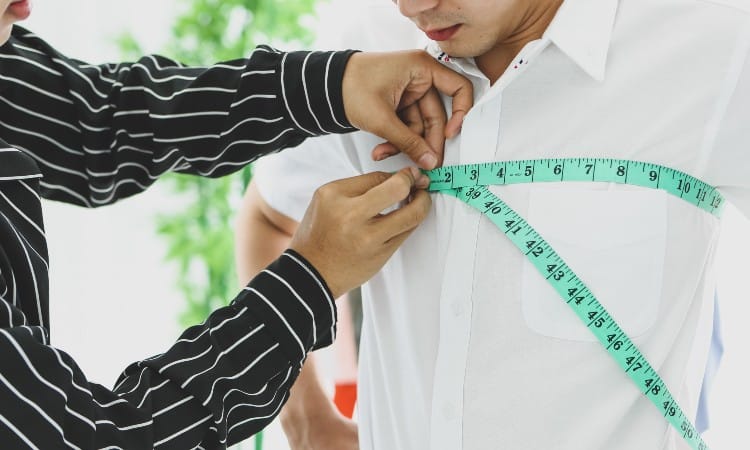
You need an accurate chest measurement for fitted dress shirts, suit jackets, and sometimes even for t-shirts, especially if you like muscle-cut tees.
Most of the time, the term chest measurement is used for men’s clothing, and bust measurement is used for women.
To take a chest measurement:
- Stand with your feet flat on the floor and your arms hanging loose at your sides.
- Hold one end of a flexible tape measure at your armpit. Keep that arm loose at your side, but use your other hand to wrap the tape around your chest.
- Do your best to circle the widest area of your chest while keeping the tape level. Use a mirror to make sure the tape does sag as it crosses your shoulder blades.
- Once you have circled your torso with the tape, pull it snug but not too tight.
- Note down this number.
- For dress shirts, you typically add two inches to that measurement.
- For suit jackets, you leave the number as-is.
Bust
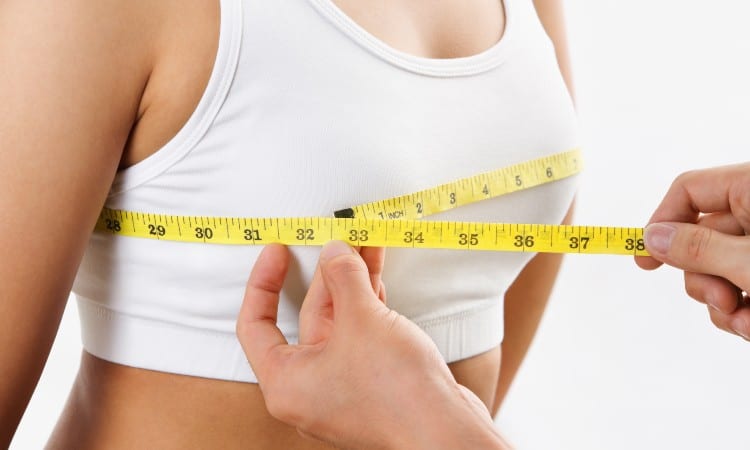
Understanding how to take an accurate bust measurement helps women buy the right bras, swimsuits, dresses, and shirts. This gets a little tricky because you often need two or even three separate measurements for some kinds of garments. These measurements are a bust measurement, underbust measurement, and bust height measurement.
For dresses, shirts, and jackets, you usually only need a regular bust measurement. For bras and swimsuits, you will need both a bust and an underbust measurement. Very fitted clothing like bodycon dresses or formal gowns sometimes also require a bust height measurement.
To take these three measurements:
- For a bust measurement, wrap a flexible tape measure around the widest portion of your bust, keeping the tape level as it crosses your back. If you feel comfortable, this measurement does work best when another person can hold the tape in place for you. Pull the tape snug but not tight; you should not have enough slack to stick a finger beneath the tape, but you should not see the tape denting your skin.
- For an underbust measurement, place one end of the tape at the center of your chest just below the lowest curve of your breasts. You can also think of this as the place the band of a bra circle your torso. Wrap the tape around your chest at this point, and note down the measurement.
- For a bust height measurement, place the tape at the base of your neck or the point where the collar of a shirt would meet your neck. Then bring the tape down to the full portion of your bust on that side of your chest. Write down that measurement.
Waist
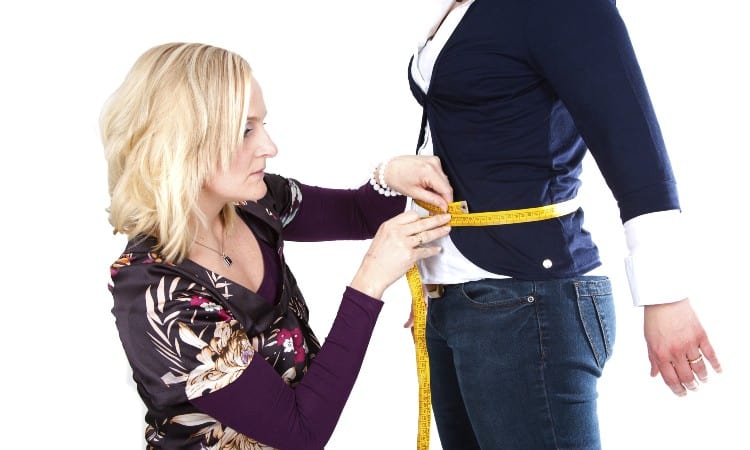
A waist measurement is crucial to finding properly fitted pants, shorts, and skirts. You also need this measurement for many styles of dresses, and sometimes for suit jackets.
For an accurate waist measurement:
- The first crucial step in taking a waist measurement is finding your waist. Your waist area spans the distance from the top of your hip bones to the bottom of your rib cage. Find the narrowest point between these two identifying portions of your torso.
- Plant your feet on the floor, straighten your back and shoulders, and breathe normally.
- Wrap the tape around the narrowest portion of your waist, using a mirror to ensure that you keep the tape level as it crosses the back of your torso.
- Breathe out and then snug the tape firmly but not tightly around this point as you check the measurement.
Hips
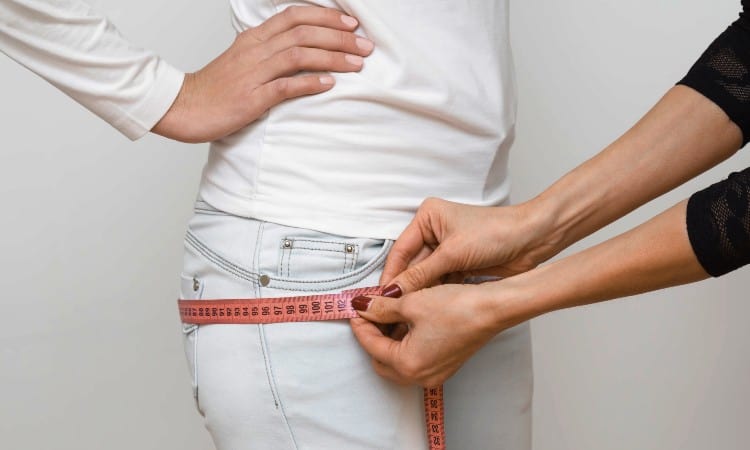
Getting an accurate hip measurement is especially crucial for women’s clothing such as pants, skirts, and dresses. Some men’s wear, like suit pants, will also require this measurement.
The tricky thing that you may not realize at first glance is that a “hip measurement” actually circles your seat as well. This measurement is often one of the widest parts of your body, making it so important! It won’t do you any good to find a dress that fits your bust and waist but can’t squeeze down over your butt and hips, for example.
To measure your hips:
- Take off your clothes, though you can keep on close-fitting undergarments if you prefer.
- Stand with your feet together but flat on the floor, and try to have a loose, straight posture through your back.
- Place one end of a flexible tape measure at the section of your hip that sticks out the farthest to one side, usually at the tip of one hip bone.
- Now wrap the tape around the widest section of your buttocks, then to the widest side of your other hip, and finally across your front in a straight line to your starting point.
- Write down the measurement where the two ends of the tape meet.
Inseam
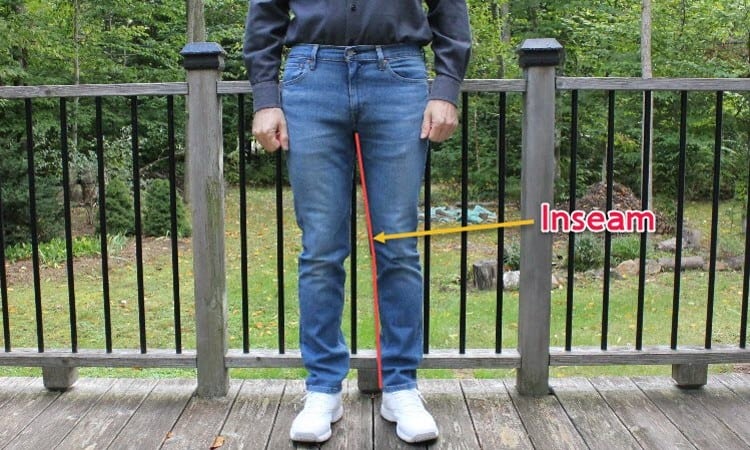
The inseam helps you get pants that have exactly the right length for your legs. Your inseam is the length between the top of your thigh and your ankle. But actually, the best way to measure this is to use a pair of pants that fit your exactly right.
To measure inseam on a pair of pants:
- Smooth out a pair of pants flat on the floor. It does not matter if the pants face front-side up or front-side down.
- Place one end of your tape measure at the cuff of the pants on top of the inner seam.
- Carefully run the tape up the length of this seam until you reach the crotch seam.
- This measurement, from the ankle to the crotch seam at the top of the thigh, will give you the inseam measurement.
- You can round up by the nearest half inch if you do not get a whole-number measurement.
Thighs
Thigh measurements usually apply to menswear like dress pants or sometimes jeans. Not every pants brand will give you a sizing chart that includes thighs, especially if the pants have a loose cut to begin with. But in some cases, you will find this measurement helpful to make sure you have pants that do not strain across the strongest muscles in your legs.
To take a thigh measurement:
- Stand with your feet shoulder distance apart, flat on the floor.
- With the help of a mirror, locate the point where your butt meets the top of your thigh. You want to measure at this point.
- Starting here, wrap the tape measure levelly around the circle of your thigh.
- Note the measurement where the two ends of the tape meet.
How to Measure for Clothes with a Tape Measure
The best way to measure for clothes is to use a flexible plastic tape measure, like the kind that comes in any sewing kit. You can find these in craft stores, grocery stores, and even most dollar stores!
The key to using a flexible tape accurately is to make sure the measure remains level all the way around your body. You can use a mirror to check on this if you have to measure yourself. If you can have a friend help you, the friend can make sure the tape does not slip down your back or gape at your waist.
If the tape does hang crookedly, wrinkle, or get twisted, you will not get an accurate measurement.
If you want an easy way to measure yourself for clothes using a tape measure, you could always try getting a specialty tape like this one with a sticky back!
How to Take Clothing Measurements for Women’s Clothing
The best way to take measurements for women’s clothing is to take careful bust, waist, and hip measurements using a flexible tape measure. You will see these three measurements used most often in sizing charts for women’s clothes.
You may also need an inseam measurement or specialty measurements such as the over or underbust. But most sizing charts for women will list the big three of bust, waist, and hips.
Remember that all three of these areas need to match up with the sizing chart, or the garment will not fit you! If a size 16 dress from a particular brand offers a hip measurement that fits you perfectly but a waist measurement three inches bigger than your waist, the dress will look baggy on you.
How to Measure for Men’s Clothes
The best way to take measurements for men’s clothing is to use a flexible tape measure to get the accurate chest, waist, and inseam measurements. Men’s clothing, like shirts, often uses a neck measurement.
Men’s pants sizes typically list the waist measurement first and sometimes include the inseam.
How to Use a Sizing Chart
Sizing charts tell you what dimensions each size of clothing will offer for a particular garment. Most charts list body parts on one axis and sizes on the other. You simply have to trace the line of the body part (such as the waist) to the appropriate size to find out the measurement.
Take a look at this sample sizing chart for women’s pants:
| Small | Medium | Large | |
| Waist | 31” | 35” | 39” |
| Hips | 34” | 38” | 42” |
| Inseam | 30” | 31” | 32” |
To use a sizing chart, you should start at the side, listing key areas of the body. For example, find the “waist” row or column and then trace along it until you find a measurement that matches your measurement. Suppose you have a waist measurement of 38 inches–in the example above, you would trace the “waist” row until you reach the column that lists 38” inches.
This would mean your waist fits size medium for this particular garment.
Of course, the potential difficulty you may run into is that sometimes your body parts do not align with the sizing chart. Suppose you have a 38” waist but a 32” inseam. In this case, the pants from the sample chart will not work for you because you fall in between a medium and large size.
Another important thing to know about sizing charts is that they typically offer measurements in inches when using US sizes and in centimeters when using EU sizes.
Finally, you can usually get away with measurements that fall a fraction of an inch above or below the measurements in the chart. If your waist measured 37.5 inches, for example, you could still comfortably wear the medium pants that have a waist measurement of 38 inches.
How Do You Measure Yourself for Clothes at Home?
You can measure yourself for clothes at home using either a flexible tape measure or by measuring a garment that fits you well.
For the tape measure method, wrap the tape in a level line that remains parallel to the floor around key areas of your body like your chest and waist.
For the garment method, measure key areas of a garment that fits you well. This works particularly well to measure sleeve length or inseam length. If you use this method for a circumference measurement like the waist, ensure you measure both the front and back of the garment.
How Do Fashion Designers Take Measurements?
Fashion designers take the same key measurements of neck, chest, waist, hips, sleeve length, and inseam to create clothing and sizing charts for customers. Designers take a lot of factors into consideration when creating ready-wear clothing, such as the average size and weight of the consumers they want to sell to.
If you want the assurance of professionally taken measurements, you can always consider visiting a tailor or alteration shop. These experts know exactly how to measure you to get the most accurate results.
For women, you could also visit a high-end bra store, where you can expect to find professional sales clerks trained in helping customers get accurate measurements.
How to Take Body Measurements for Sewing
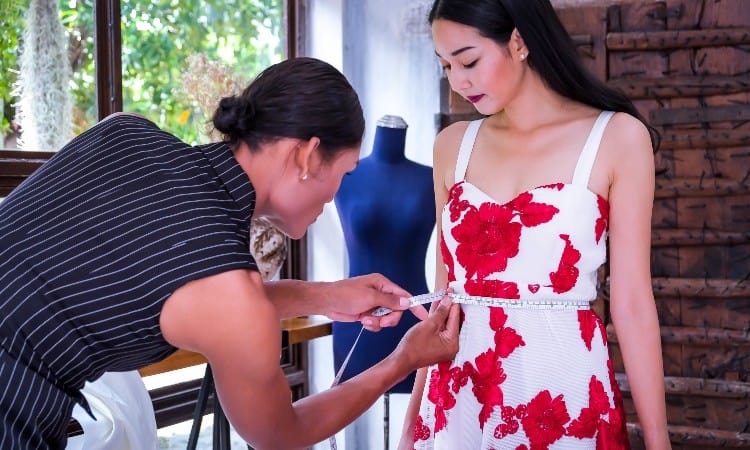
You can take body measurements for sewing in the same way as you do for buying ready-made clothes. The only difference is that you want to match your measurement to the pattern size chart rather than to a sizing chart online.
Another thing to remember is that pattern creators try to add two elements to any sewing pattern: wearing ease and design ease.
Wearing ease allows you to move and breathe as you wear the clothing. Typically, the smallest amount of wearing ease you should expect in clothing is about two inches around the bust and one inch around the waist.
Design ease describes the ease provided by design elements of a garment, such as ruffle sleeves or a boxy top.
Ultimately, this means that you could take accurate measurements and sew the pattern correctly, but if you do not like the amount of ease in the garment, you might still find it too tight. One of the best ways to avoid this problem is to make sure you use the type of fabric recommended by the pattern.
How to Measure for:
Check out these tips to learn how to measure for specific garments like a dress or suit.
Dress
For most dres sizing charts, you will need bust, waist, and hip measurements. If the dress has sleeves, you will probably also need your sleeve measurement.
As always, start by finding the size that matches your largest measurement. If a Size 8 dress matches your hip size, start there and check to see if Size 8 also has your waist and bust measurements.
Bra Size
To measure bra size, you need both the bust and underbust measurements. The underbust measurement will equal your band size.
For the cup size, subtract the underbust measurement from the overbust measurement. Every inch of the remainder will equal one letter size.
Shirts
For most shirts, you will need either a chest or bust measurement and sleeve measurement.
Men’s dress shirts use a two-part size. This sizing system lists the neck measurement followed by a slash and then the sleeve measurement. Remember that the neck measurement will include an extra half inch beyond your actual neck measurement.
Jeans
The key measurements you need for buying jeans are waist measurement and inseam. For women, jean sizes typically come in numbered sizes ranging from 0 to 22. You will want to check the sizing chart from the jeans brand to see what measurements those sizes feature.
For men, jean sizes have a more simple approach. The size uses waist measurements, such as 30, 32, and so on, to tell you exactly what you will get!
Suits
You need sleeves and chest measurements as you buy a suit jacket. Men’s suit jacket sizes usually list the chest measurement and then the length. The chest measurement is listed in inches, followed by a letter describing the length, like R for regular or L for long.
For dress pants, you always need a waist and inseam measurement. You may also need a thigh measurement, especially if you like wearing tailored slacks.
Clothing Measurements App
There is an app for everything, so you can also use a clothing measurements app to find your size! Apps such as TailorGuide and MySizeID offer another easy way to take your measurements.
TailorGuide can take your measurements from a few selfies. Do these measurements offer the level of accuracy of a tape measure? You should probably try both methods the first time to compare. You can find this app in the Google Play Store for Android users.
MySizeID works similarly, but you can find this app in the iStore for Apple users.
Conclusion
Learning how to take measurements for clothes will save you hours of endlessly trying on clothes off the rack in a department store. It will also help narrow down exactly which jeans, dresses, or tops will fit you as you shop online.
The key measurements you need for most clothing include the neck, chest, waist, and hip circumference. You may also need sleeve length or inseam measurements for clothes that have long sleeves or for pants.
Have you tried measuring yourself for clothing sizes? What method did you use? Leave a comment below to let us know!